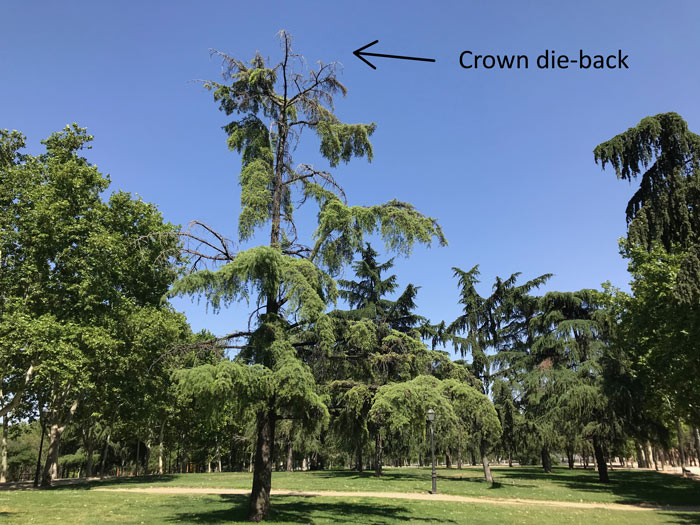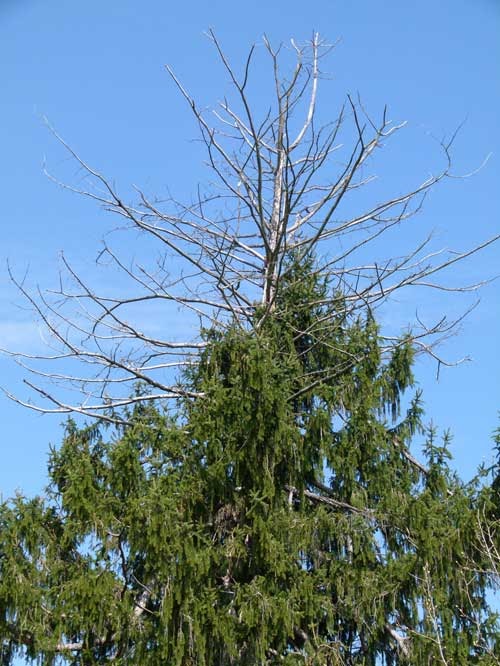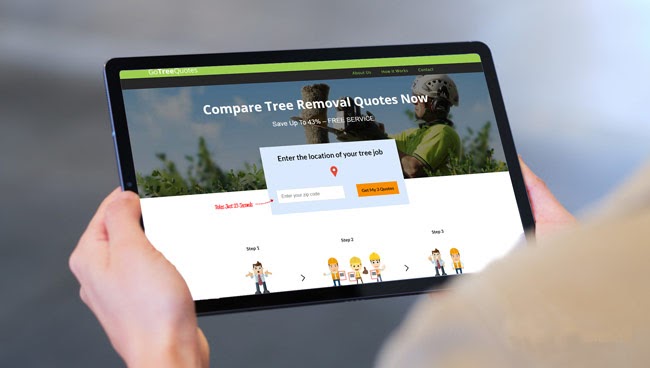As soon as you notice your tree beginning to perish, it’s crucial to identify the underlying issue causing the decline prior to engaging in any efforts to save it. This is important since the fundamental reason behind the problem largely influences if the tree can be rescued. Additionally, it affects how successful any actions you undertake to halt the tree’s deterioration will be.
A common problem that tree owners face is a tree that starts dying from the top down. Unfortunately, there is no one-size-fits-all solution for this problem since the underlying cause of the problem usually varies from tree to tree and from circumstance to circumstance. Here is what you should know about what it means when your tree starts dying from the top down and the possible treatment options that are available to you.

What we cover
ToggleWhy are only the top branches of my tree dying?
Only the top branches of your tree are dying because your tree is having a harder time supplying these branches with water or nutrients. This may be a result of pests burrowing through the trunk, a water shortage that forces the tree to shed off some of its limbs, or a lack of healthy enough soil to support all of the tree’s limbs.
However, in some cases, only the top branches die off because that is where a disease, or pest, starts its invasion. And so the gradual death is simply a symptom of spreading a disease or a growing infestation.
Why does the bottom stay alive?
The bottom stays alive because it can still be supplied with nutrients, water, and food. This may be a result of the tree’s food and water transportation system not being compromised at this level by pests or diseases. It can also be a matter of the tree entering into survival mode where it sheds off the top leaves as a way of reducing the strain on limited resources. In other cases, the bottom stays alive simply because it hasn’t yet been affected by the disease or pests that are affecting the top.
Top causes of trees dying from the top?
Trees die from the top because of a variety of reasons. The following are the most common causes of this problem.
Soil Health
When a soil’s pH is off or when it doesn’t have enough nutrients to support tree growth, it is normal to see trees in such soils start to die. This is because poor soil health usually translates to a lack of enough food to adequately support food production and tree growth. As a result, testing the soil’s pH, checking for signs of soil organisms, and measuring its porosity may be necessary in order to determine whether it is to blame for your tree dying.
Soil compaction
Highly compacted soil does not have enough air to support healthy root growth. The lack of microbial activity also tends to have fewer nutrients. This, in addition to making root penetration harder, usually translates to the tree’s inability to take in as much water and nutrients as it needs. This may lead to the tree dying slowly, starting with the top branches and leaves.
Root stress
If a tree’s root system becomes physically damaged, or if they are having a hard time penetrating the soil, it won’t be able to absorb water and nutrients from the soil. This strain on resources can prove to be too much for the tree to handle, and it can thus start dying.
Insects
Most bark beetles4 boreholes into the trunks and branches of tree trunks and branches. The resultant effect of their action is a compromised plant transportation system that essentially starves part of the tree. The wounds that they create can also cause infections and diseases that may add to the stress that the tree is experiencing. As a result, these trees tend to die slowly from the top down.
Fungal disease
Fungal diseases like Cytospora cankers1 are notorious for causing top-down dying among hardwoods like poplars, willows, aspens, and maples. When left untreated, the wilting and branch dieback that they cause slowly spreads to a point where it kills the entire tree.
Drought
Trees that are not suitable for drought conditions become stressed because inadequate water availability usually compromises their ability to produce food. It also tends to leave them vulnerable to disease and insect attacks. As a result, it is not unusual to see such a tree start to develop yellowing and wilting leaves from the top down.
Air pollution
Although trees are renowned for cleaning carbon from the air, there are hundreds of other toxic chemicals that are detrimental to a tree’s health and some trees are more sensitive than others.
Mistletoe
Oak Wilt





Can a half-dead tree be saved?
Yes, a half-dead tree can be saved. This can be done by cutting off the dead parts as a way of stopping a spreading infection. Trimming the tree can also relieve the strain on existing resources thus giving the tree a chance of surviving. Pesticides and other treatments can also eliminate the root cause of the death, and this is sometimes enough to save the tree.
However, whether a half-dead tree can be saved largely depends on the tree species, the cause of the death, and the care that the tree gets after treatment.
How to save a dying tree
In order to save a dying tree, you need to take the following steps.
Identify the source of the problem
The first step should be to diagnose the cause of the dying problem. In order to do so, you may have to conduct a pH test, check the soil compaction, and look for signs of pest infection like holes in the trunk.
You may even have to go through tree pest and disease databases to confirm whether the symptoms that your tree is displaying match those of common or known tree diseases. And since determining the source of the problem is tricky, contacting an arborist is usually advisable.
Administer the right treatment or medication
After identifying the problem, you then have to swing into action in order to help the tree to recover. If pest infestation is the problem, then you should apply the recommended pesticides. And if it is a problem with the soil, then improving its aeration, and soil pH, and ridding it of harmful organisms is something that you should do.
Water
A lack of moisture stresses a tree. It can even cause it to start dying. And even if it is not the cause of the death, it can accelerate the process. Therefore, providing your tree with the right amount of moisture will boost its recovery. It will also help to prevent bacterial and insect attacks, something that will improve the tree’s odds of survival.
Fertilize
With fertilization, you will ensure that the tree has all the essential nutrients that it needs to recover and survive. And if it is a lack of nutrients that triggered the dying process, the nutrients that the fertilizer provides will be enough to solve the underlying problem. And even if it is not, having enough nutrients will boost the tree’s ability to produce food and fight off diseases, something that will definitely help in the recovery process.
Prune
After making sure that the tree has enough water and nutrients, you should consider pruning it. This is because with the right pruning techniques, you will be able to cut off diseased or pest-infested limbs and this will slow the spread of pests and diseases.
In the case of a tree that doesn’t have a pest or a disease problem, pruning can help to reduce the strain on resources that comes with having a lot of foliage and limbs. It can also reduce the weight that a weakened tree has to bear, and this may be enough to help it recover.
Who to call if my tree is dying?
If your tree is dying, you should call an arborist. Qualified arborists typically have the knowledge, training, expertise, and experience required to make the right diagnosis, prescribe the necessary treatment measures, and even administer them. They can also advise you on whether it is worth saving the tree and if removal is a way better alternative.
Use this free service to find an arborist near you
If you have a dying tree, contacting an arborist as soon as possible is advisable. And the best way to do so is to start by visiting GoTreeQuotes.com. It offers a free service that quickly matches you with the top-voted local tree care experts in your area.
Using the website, you can get 3 estimates fast by real certified experts in your area in just 2 minutes. Here is how it works.
- You scroll to the top of the page and enter your Zip code.
- Answer questions about your tree care needs
- Your details will be forwarded to three local experts.
- You will then receive a price estimate for the job and some friendly advice.
IMPORTANT: There is no obligation to hire. This is a free tool and service to be used at your pleasure.

FAQ's
Yes, trees can die from the bottom up.
In the case of evergreen trees, this typically happens in cases where there is a shortage of water during drought periods. The needles and leaves that are located at the bottom may start to fall off in an attempt to help hydrate the rest of the tree.
For trees that lack sunlight, they may start dying from the bottom simply because the leaves and needles that are located at the bottom tend to experience acute cases of deprivation. They will therefore shed off first before the ones that are located at the top.
A tree may also die from the bottom up if it is infected by certain pests or diseases. For example, the CytoSport canker disease and pine beetles have a well-earned reputation for causing bottom-up tree deaths.
The best way to tell whether your tree is dead or dormant is to perform a scratch test. To do so, simply scratch the bark with a knife in such a way that you scratch past the outer tougher layer. When you do this, you should see a green layer. If you do, it means that the tree is simply dormant. But if you don’t and you end up seeing a brownish layer, then the tree is dead.
You can tell if a tree is dying by looking for the following common symptoms.
- The most common sign of a dying tree is its leaves turning brown during its growth period. If a tree that typically thrives in summer starts to develop brown leaves, and if it starts to shed foliage, then chances are that it is dying.
- Deep splits in the bark and bark that is falling off is also a sign of a tree that is possibly dying. This is so especially if the bark turns brown and becomes brittle.
- If a significant portion of the tree’s branches is made up of deadwood, then the tree is probably dying. This may be due to water or nutrient shortage. It can also be due to an infestation.
- The presence of some pests, like carpenter ants and bark beetles, can also be a sign that a tree is dead or dying. This is mainly because these pests typically infest dying or stressed-out trees.
- Some fungal growths, like mushrooms growing a tree’s base, only occur in cases where a tree is dead or dying. Therefore, if you notice any signs of these growths, your tree is likely dying.
- Trees that lean at angles that are more than 15 degrees are typically weak or structurally compromised. They rarely survive for long periods. Therefore, if your tree suddenly adopts an odd growing angle (lean), there is a possibility that this is due to it dying.
- When you scratch your tree’s bark with a knife, it should reveal a green layer. If it doesn’t and it instead reveals a dry and brown layer, then it is probably dead or dying. This is because it means that the tree has failed the scratch test.
- Michelle Grabowski and Cynthia Ash Kanner, (2018) Cytospora Canker. <https://extension.umn.edu/plant-diseases/cytospora-canker> Accessed: 20-02-2024
- Jill O’Donnell and Bert Cregg, (2019) Why Are My Pine Trees Turning Brown? <https://www.canr.msu.edu/news/why_are_my_pine_trees_turning_brown> Accessed: 20-02-2024
- Jennifer Juzwik, Brian Schwingle and Matthew Russell, (2023) Oak Wilt in Minnesota. <https://extension.umn.edu/plant-diseases/oak-wilt-minnesota> Accessed: 20-02-2024
- University of Maryland Extension, (2023). Conifer Bark Beetles on Trees and Shrubs. <https://extension.umd.edu/resource/conifer-bark-beetles-trees-and-shrubs/> Accessed: 20-02-2024




